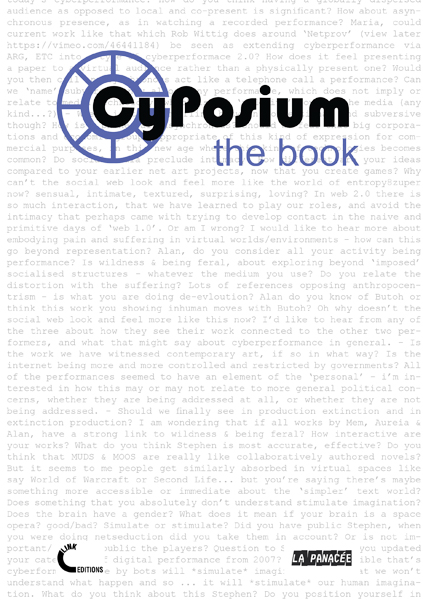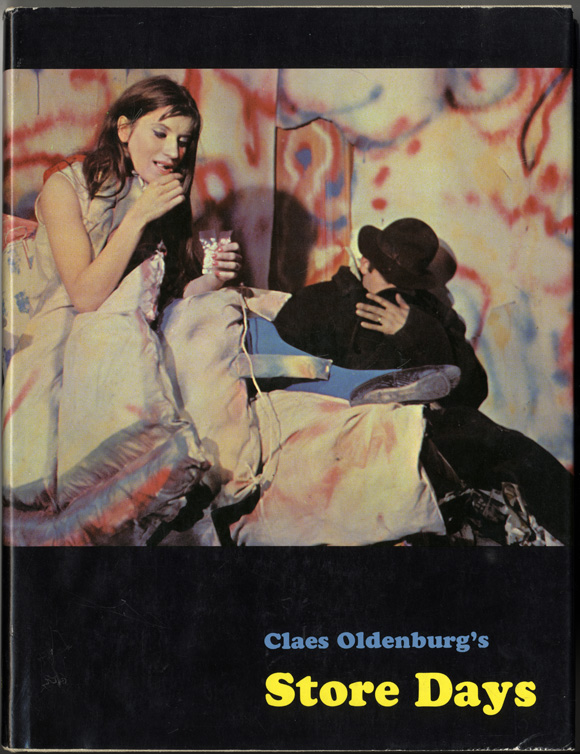Annie Abrahams, Helen Varley Jamieson (eds.): CyPosium: The Book (2014)
Filed under book | Tags: · art, internet, performance, performance art, theatre

“In October 2012, a one-day online symposium created a platform for discussing the practice of cyberformance – live performance that uses internet technologies to connect remote participants. The 12-hour event featured 10 presentations and attracted an audience of over 100 from around the world who engaged in a lively, vibrant conversation. CyPosium – The Book presents a selection of artefacts from the CyPosium – presentation texts, chat log excerpts, discussion transcripts, edited email conversations, creative chat excerpt essays and illustrations – along with invited articles that respond to the event. The contributors hail from a wide range of artistic practice both online and offline, and their writing illustrates the hybridity of contemporary arts involving digital technologies.”
Contributors: Adriene Jenik, Alan Sondheim, Alberto Vazquez, Annie Abrahams, Auriea Harvey and Michaël Samyn, Cherry Truluck, Clara Gomes, Helen Varley Jamieson, James Cunningham, Joseph DeLappe, Liz Bryce, Maria Chatzichristodoulou, Maja Delak and Luka Prinčič, Miljana Perić, Rob Myers, Roger Mills, Ruth Catlow, Stephen A. Schrum and Suzon Fuks.
Publisher Link Editions, Brescia, with La Panacée, Centre de Culture Contemporaine, Montpellier, 2014
Creative Commons BY-NC-SA 4.0 International License
ISBN 9781291988925
171 pages
De Ridder Retrospective (1983) [NL/EN]
Filed under artist publishing, catalogue | Tags: · art, fluxus, performance, radio art, theatre

Book with comic strips, conversations and a chronology of Dutch radio art maker, magazine editor and Fluxus member Willem de Ridder, issued to accompany his retrospective at the Groningen Museum in the Summer of 1983. The part in English starts on page 34.
“In 1961, Willem de Ridder set up Mood Engineering Society together with Peter Schat, Wim T. Schippers, Misha Mengelberg, Jaap Spek, Louis Andriessen and Govert Jurriaanse, most of them avant-garde musicians. Among their first activities was De Ridder’s Papieren konstellaties [Paper Constellations], which could be ‘constructed’ anywhere as long as an audience was present to participate in this so-called PK theatre and help determine its appearance. Traditional theatre, it was felt, had to be given the boot. It had remained stuck too long in the renaissance model of the proscenium stage and should be replaced by dynamic, mobile installations, variable acoustics and–following John Cage–the theatricality of silence, which, it was anticipated, would make the audience restless. The group performed three concerts in February 1962. Fully in the spirit of Fluxus, the hierarchy between artist/composer and performer as well as between performer and audience was abolished. Objects fulfilling a clearly visual function, such as a tape recorder, were featured in the concerts. The introduction of a visual element suited the ambition to destroy the traditional boundaries between the disciplines of art, following Cage’s example. After the concerts, MES was dissolved, despite the fact that various museums in the country were offering them the opportunity to put on new performances. De Ridder became a representative of Fluxus for the Netherlands in 1963.” (Marga van Mechelen, 2006)
Written and compiled by William Levy and Willem de Ridder
Publisher Groninger Museum, Groningen, 1983
ISBN 906477062X, 9789064770623
80 pages
via thepiratebay.worm.org
PDF (33 MB)
Comment (0)Claes Oldenburg: Store Days: Documents from The Store, 1961, and Ray Gun Theater, 1962 (1967)
Filed under artist publishing | Tags: · art, happening, installation art, performance, performance art, sculpture, theatre

““I’d like to get away from the notion of a work of art as something outside of experience, something that is located in museums, something that is terribly precious,” Oldenburg declared. In 1961 he presented a new body of work whose subject matter he had culled from the clothing stores, delis, and bric-a-brac shops that crowded the Lower East Side. The earliest Store sculptures, which debuted in spring 1961 at the Martha Jackson Gallery, at 32 East Sixty-Ninth Street, are wall-mounted reliefs depicting everyday items like shirts, dresses, cigarettes, sausages, and slices of pie. Oldenburg made them from armatures of chicken wire overlaid with plaster-soaked canvas, using enamel paint straight from the can to give them a bright color finish. At the gallery, the reliefs hung cheek by jowl, emulating displays in low-end markets.
In December 1961, Oldenburg opened The Store in the rented storefront at 107 East Second Street that served as his studio, which he called the Ray Gun Manufacturing Company. A fully elaborated manifestation of the project that he had begun months earlier, The Store conflated two disparate types of commerce: the sale of cheap merchandise and the sale of serious art. Oldenburg packed more than one hundred objects into the modestly sized room, setting previously exhibited reliefs alongside new, primarily freestanding sculptures. Everything was available for purchase, with prices starting at $21.79 up to $499.99. After The Store closed, on January 31, 1962, Oldenburg used the space to stage a series of performances collectively titled Ray Gun Theater.” (Source)
Selected by Claes Oldenburg and Emmett Williams
Photographs by Robert R. McElroy
Publisher Something Else Press, New York, 1967
152 pages
via penfold
PDF (83 MB)
Comment (0)
